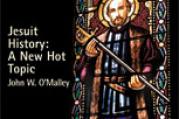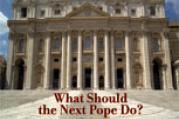Click here if you don’t see subscription options



A Very Simple Message
Much of the world stood still recently, at least for a few moments, to observe the passing of Pope John Paul II. Television coverage of the crowds of pilgrims making their way to view the body one last time was extraordinary. In a world often deemed indifferent to religion, who would have guessed a humble Polish priest would become a pope the whole world would mourn (4/18)?
I am a Catholic by birth and an editor at a Catholic publishing house by profession. Even among those of us who might be called professional Catholics, there has been a sense of awe and wonderment at the life and accomplishments of John Paul II. In August 2002 I watched television coverage of a visibly ailing, 82-year-old pontiff saying Mass in a field outside Krakow. The crowd was immensean estimated three million people. Everywhere John Paul II went there were crowdsseven million in the Philippines. His general audiences in Rome were attended by 14 million people. It’s difficult to imagine a person living or dead who has seen or been seen by more people than John Paul II. Why?
I decided to search for an answer by immersing myself in John Paul’s writings. He is perhaps the papacy’s most prolific writerauthor of 14 encyclicals, 42 apostolic letters, 15 apostolic exhortations, 10 apostolic constitutions, hundreds of public addresses, numerous poems, five books and a number of playsall this in addition to being the most traveled and most influential pope of the modern age.
What really amazed me, though, was the fact that the magnitude of John Paul II’s accomplishmentsas world statesman, theologian, philosopher and church leaderhad perhaps obscured his greatest role: that of a humble pastor. He knew something about how men and women can find God. He understood how the power of God can be released in our lives. His supreme desire was that we come to embrace a faith that transforms the way we work, the way we relate to other people and the way we live in the world.
John Paul returned again and again to a few basic themes in all his writings and talks: faith, prayer, family, suffering, the church, Mary and, most passionately, ChristChrist as the answer to all life’s mysteries. He traveled the world bringing this very simple message.
Though the papacy of John Paul II has ended, his legacy lies tangibly before us in his writings. We can touch his books, hold his pages in our hands, take his words into our hearts. We should do this. He wanted us to. In so doing we may discover that the secret to John Paul II’s immense popularity was that he really believed in a faith that could change the world for the better. His words will bear eloquent witness to this hope for many years to come.
Joseph Durepos





Toward Reconciliation
Catholicism, Death and Modern Medicine (4/25) was a splendid article by Lisa Sowle Cahill. Waiting until the dust settled on this traumatic event was wise and effective. We know that timing in such matters is of great importance. The crux of her argument lies in her statement it would seem, the rejection of the means of life-prolongation is not tantamount to directly desiring that the patient be dead, but rather to acceptance of death as now timely and a part of the human condition. It was determined after the autopsy that Terri Schiavo suffered no abuse or neglect, so we should assume Terri’s husband did not desire her dead. It also seems that her parents, who loved her very much, had a hard time accepting death as part of the human condition. With the help of thoughtful writings such as Ms. Cahill’s, one hopes reconciliation between parents and husband can go forward.
Howard Grandjean


